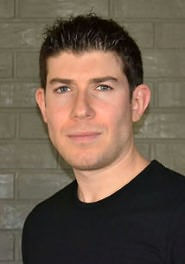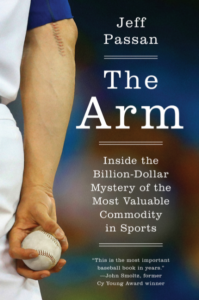
Looking Closer at Pitching Injuries: An Interview with Jeff Passan
Today, I’m fortunate to have an interview with Yahoo Sports baseball writer, Jeff Passan. Jeff spent the past few years traveling the country to research why arm injuries in pitchers are at an all-time high, and his efforts culminated with the recent release of The Arm. I’ve read it, and it’s fantastic.
EC: Why did you write this book?
JP: Originally, I wrote it because I thought maybe, just maybe, through reporting and research I could find a fix-all for elbow injuries and help rid the sport of Tommy John surgery. What I learned was that I was foolish to even conceive of that, considering people far smarter than I am have dedicated their careers to ramming dead ends. Because of that, while I still think the recoveries of Daniel Hudson and Todd Coffey are the heart of the book, I began to realize just how acute this is for children. When nearly 3 in 5 Tommy John surgeries is done on a teenager, and the rise of teenage surgeries has gone in lockstep with the ascent of the showcase circuit and desire for velocity, something is very wrong. This is a book about a lot of things. I hope amid those, the lessons to parents resonate and cause them to think twice this spring about sending their young kids especially back out for an extra inning or keeping them in the game too long.
EC: Let’s stay with the teenage discussion, as I’ve been preaching about this problem it for a decade now! When you investigated the current state of teenage baseball, what did you find? And, what surprised you the most?
I found a wasteland of ignorance, greed and scars on the elbows of children. I always heard executives complaining off-handedly about the showcase circuit but didn’t realize the pervasive grasp it has on the youth space. Major League Baseball’s greatest failure was allowing a for-profit company to co-opt its pipeline. As much as Perfect Game wants to claim moral superiority and a concern for the arms of children, reality tells a different story. Showcases 11 months of the year. Radar guns trained on infielders throwing across the diamond. Out-of-control pitch counts for arms simply too young to handle the workload. And that’s to say nothing of actively seeking out sub-standard players to fill out an event. The commodification of children is gross, and encouraging performance and winning over development at young ages simply reinforces some of the same principles that I fear ultimately lead to arm injuries.
EC: Many people claim these issues are isolated to just the United States, and that the Far East and Latin American are immune. They deny that arm injuries are occurring at high rates in these areas; what did you find?
At the major league level, one’s ethnicity does not make him any likelier to hurt himself. The numbers are pretty flat across the board. We see with Latin American players how that manifests itself because so many spend their formative years in the minor leagues and we witness their ascent and, in unfortunate cases, injury. Japanese pitchers, on the other hand, have a reputation of clean mechanics and hard work, and while that may be true, the results are devastating. It’s not just the recent study that showed 40 percent of a sample of 9- to 12-year-old Japanese children had suffered ulnar collateral ligament damage. It’s what I saw first-hand: Little boys, some so young their adult teeth still weren’t fully grown in, coming into a clinic especially for baseball players and being diagnosed with an arm injury. Avulsion fractures. Frayed ligaments. OCD lesions. You name it, these kids had it. And it made me wonder how the Japanese baseball culture can live with itself knowing that it’s choosing blind tradition over something as fundamental as the health of children.
EC: Everyone likes to play Major League Baseball general manager on the internet, but I’m going to do you one better. I’ll let you be MLB commissioner and task you with determining how to address the injury epidemic that’s spanning from youth leagues all the way to MLB veterans. How do you handle it?
JP: Wow. OK. So, I’m assuming an unlimited budget here, because a lot of these things are going to take money. Let’s start with the kids first. I appreciate what Pitch Smart is trying to do. I also think it’s not conservative enough with the youngest kids. If baseball is injuring its youngest players — and doctors and studies alike believe it is — we need to focus on the two likeliest culprits: overuse and excessive maximum-effort throwing. Curb the first with lower pitch limits. It’s not like 8- or 9-year-old kids need to be building toward triple-digit pitches. And in concert with that, advocate an epistemological change in how we approach youth baseball: as an apparatus for development over competition. Don’t get me wrong. Competition is great. But if competitiveness in this space leads to the things that lead to an increase in injuries, we can satisfy our competitive jones elsewhere and instead emphasize developing safer development and the importance of control and command over velocity. This demands better coaching, and free coaching clinics run by MLB-trained advocates at least gives us a better chance of empowering those whose voices are critical with the necessary education.
There are so many more things in the youth space I could do, but I want to move on to the pros, because if I were in power and had carte blanche, the first thing I would do is force the 30 teams to abandon their injury-prevention fiefdoms and band resources to help start solving this problem. This is a matter of the greater good. Baseball as a sport is facing another generation of pitchers arriving with Tommy John surgery scars on their elbows, and if a team found something that could mitigate injuries, those children deserve to know. I understand the desire for a competitive advantage. I also see this as a moral imperative for baseball to do what it can to solve it. Beyond that, continuing to fund the current epidemiological studies, working hand in hand with the tech companies — so many of which seem to have a problem getting their products to market — and pioneering in-house research through a think tank-like establishment devoted not just to the arm but varying other ends of research. In other words, I’d throw the full weight of MLB behind this, not just monetarily but starting with the first commercial of the World Series, which is a close-up camera shot first on Matt Harvey’s elbow, then Stephen Strasburg’s, then Jose Fernandez’s. And as the camera pans back to reveal their familiar faces, each says: “This could be you.” Then some stats on year-round baseball — oh, yeah; as commissioner, I’d shut that down and hold twice-a-year showcases at which the top prospects can show up and show off their stuff for everyone in the industry, like a combine — and some other scary numbers and, boom: Immediate education on Tommy John surgery through people not wearing white lab coats.
EC: Thanks for joining us, Jeff! Whether you’re a baseball player, coach, parent, scout, or fan, I’d strongly encourage you to pick up a copy of The Arm.




